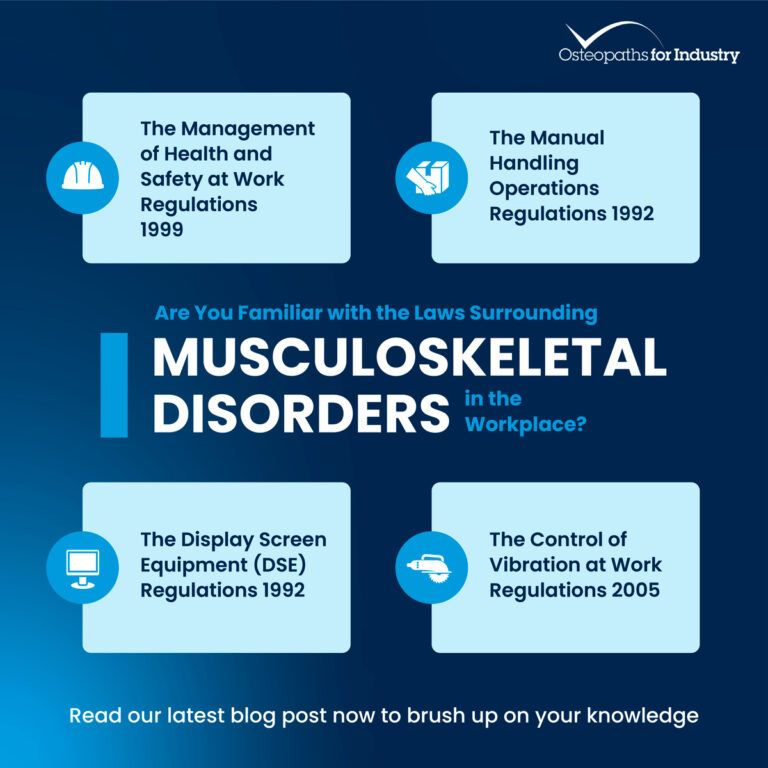Reducing Risk, Promoting Safety: The Laws on Work-Related Musculoskeletal Disorders
Think of your workplace as an ecosystem: each constituent element works together to produce output and achieve its goals. One essential thing is to maintain the health of this ecosystem so that your team can stay feeling happy and productive.
The threat of musculoskeletal disorders (or MSDs) underlies all work-related tasks, whether the employee physically handles heavy equipment or works at a desk – even in situations where the risk is less obvious, it doesn’t mean that it’s not there. Luckily, there are many laws in place to help you and your employees optimise their health and safety at work. In this blog post, we’re breaking down the different regulations surrounding work-related MSDs to help you comply with the rules, mitigate risks, and maximise occupational safety.
What are work-related musculoskeletal disorders? According to the NHS, musculoskeletal disorders refer to a group of conditions affecting the bones, muscles, joints, and spine. These conditions include back pain,₁ arthritis, stiffness, and osteoporosis, among many other types of discomfort and pain.₂
Work-related MSDs specifically refer to injuries or pain caused or triggered by activities in the workplace. These may include carpal tunnel syndrome caused by typing, tension neck syndrome from prolonged sitting, and more serious back and knee injuries resulting from lifting and/or operating heavy equipment.₃
Some common risk factors for the development of work-related MSDs include: ₄
- Repetitive work, such as sustained typing₅
- Use of display screen equipment (or DSE) like computer monitors₆
- Working with heavy power tools
- Lifting and moving heavy loads
- Improper working environment (i.e. poor lighting, constrained spaces)
- Driving large vehicles over long distances
- Improper home-based set-up (i.e. chairs without lumbar support) for remote or hybrid workers₇
The legal guidance surrounding occupational safety in the workplace can help control and remove these risk factors for you and your employees. It is vital to follow this guidance as MSDs can cause lifelong chronic pain and disability for affectees.₈ Let’s move on to the laws surrounding work-related MSDs and learn more about how they can help you safeguard your employees against serious health and safety risks.

Musculoskeletal conditions pose a significant threat to employees in UK businesses. The NHS reports that an average of 30 million working days are lost to musculoskeletal pain on an annual basis, with over 20 million people in the UK suffering from this type of pain. As an employer, this staggering number underlines the importance of giving the prevention and management of work-related MSDs immediate attention in order to prevent productivity losses and keep your team well.₉
The Laws Surrounding Musculoskeletal Disorders in the Workplace
There are many different rules and regulations surrounding occupational safety. These largely fall under the Health and Safety at Work Act of 1974. This crucial piece of legislation mandates employers to protect the health and safety of their workers.10 Under the ambit of this law come more detailed regulations that cover MSD risks as well. To help simplify these rules, let us explore what these laws say and remind ourselves how we can best follow them.
The Management of Health and Safety at Work Regulations 1999₁₁ These laws provide a key framework for related MSD laws. This framework involves:
1. Identifying risks of injury or illness in your workplace
2. Determining the seriousness of the risk (including identifying who is most vulnerable)
3. Evaluating the steps needed to control or remove the risk
This framework for risk management can be summarised as IAS – Identify, Assess, and Control. While this law covers wider health and safety hazards, you may find risks relating to musculoskeletal disorders. When applied to MSDs, this framework may look something like:
1. Identifying risk: A project requiring detailed documentation could lead to prolonged typing and keyboard use. This could cause your employee to experience joint pain and/or discomfort. They might also experience back pain₁₂ from sitting down at their workstation for extended periods.₁₃
2. Determining the seriousness of the risk: You estimate that the task will take around 5-6 hours to complete. This is in addition to prior computer-related tasks your employee has already been assigned. The repetitive work and sustained physical effort of typing can trigger severe joint pain, especially if your employee already experiences any other arthritis-related symptoms.₁₄
3. Controlling or Removing Risk: The task is necessary to complete the project. As a result, you should try to control how it is performed. For example, you could split the workload between 2 employees and mandate rest breaks in between typing time, e.g. after every 1 hour of DSE usage. Similarly, you should make sure everyone using DSE equipment in your workplace has access to ergonomic furniture, including chairs with lumbar support and keyboards with a curved structure designed to promote wrist comfort. You could also consider extending the deadline to split the typing time over a week.₁₅
In this way, the IAS model provided by this regulation can help your employees perform and feel their best.
Manual Handling Operations Regulations 1992 ₁₆
Manual handling work refers to the movement of a load by hand or bodily force. This could include lifting, dragging, putting down, or carrying. Under these regulations, the framework of assessing and controlling risk is applied to these loads (which could be an object, person, or animal). If your employee is tasked with any manual handling work, you must:
1. Avoid dangerous handling by adjusting the task or automating the process: This means you should decide whether or not the task is unavoidable. If deemed unnecessary, the load should be avoided or left as is. Similarly, you should consider using machinery (like a hoist) to do the job instead of an employee.
2. Assess the risk for unavoidable tasks ₁₇: If the load has to be moved, you must first assess the many risk factors involved in the transportation process. To do this, you should look at the physical space available. Some key considerations include ensuring there’s enough space to move the load, that the floor is not slippery, and that the temperature is comfortable (to avoid excessive sweating and physical exhaustion). You must also assess the assignee’s physical capabilities and willingness. You should never pressure your employees to move a load they do not feel comfortable handling.
3. Make efforts to reduce the risk of injury: As an employer, you must make use of machinery or tools to move loads when possible. This might mean using a trolley or hoist instead of getting your employee to physically lift heavy loads. You should also consider lowering the risk level by reducing the size of the load, providing an open space for transportation, and ensuring that your employees receive proper training for any manual handling work. At Osteopaths For Industry, our experts can tailor this training to the specific needs of your workplace and are available for training online or on-site, at your workplace.₁₈ ₁₉
OFI’s Manual Handling services include:
- A Practical Skills Training course for your employees₂₀. Our experts will review your current manual handling policies to develop a bespoke course teaching your employees how to limit the risk of injury, practice safe and effective lifting, manoeuvre awkward loads, and gain a broader understanding of dynamic handling techniques.
- 2 or 4-day Instructor Training courses₂₁ that can refresh your manual handling instructors’ knowledge, teach them new risk assessment strategies, and make sure they’re up-to-date with the latest manual handling safety practices. The course also offers access to a panel of expert instructors for post-course guidance, detailed notes that can be accessed at any time, and short support slides that trainers can customise for future training sessions.
- Risk Assessor Training courses to train other members of staff as risk assessors₂₂. Our expert risk assessors will visit your site to conduct a company-specific manual handling risk assessment, offer any refresher training to existing risk assessors, and provide your staff members with the expert guidance, course notes, and educational material needed to become new internal, on-site risk assessors.
- These services can also be provided online₂₃. Our Manual Handling experts can visit your workplace to film tutorials on-site, explain safety measures, create bespoke online assessments, and set up online reporting tools to keep track of your employees’ training progress. This web-based solution can be adjusted to include specific features and tutorials according to your needs.
Display Screen Equipment (DSE) Regulations 1992₂₄
These regulations safeguard employees against MSD risks caused by the use of display screen equipment like laptops, computer monitors, tablets, and other screens used for work-related tasks. The regulations follow the framework of:
1. Assessing the risk by conducting workstation assessments to ensure the set-up is ergonomic (i.e. chairs have lumbar support, screens have anti-glare filters, and keyboards are legible).
2. Reducing the risk by scheduling breaks for DSE users, asking about any symptoms of discomfort or pain, and offering to replace and/or provide new equipment, better lighting, and any other facilitative technologies. As an employer, you are also required to schedule an eye test for any users experiencing ocular discomfort or strain.
3. Providing regular training for DSE users, particularly when setting up a new workstation. At Osteopaths For Industry, we can help you with your DSE risk assessment, provide online training for your employees, and even visit you on-site to offer bespoke guidance.₂₅
Here at OFI, we offer:
- Assessor training courses₂₆ that help DSE users learn risk reduction strategies, understand MSDs, complete DSE assessment forms, set up ergonomic workstations, and follow instructions on how to monitor and review MSD risks. These services can be tailored to the specific requirements of your workplace.
- An Online DSE Assessment Tool for home-based and office workers₂₇. This tool offers online user training through videos and interactive digital content, comprehensive assessments with follow-up reports to track your employee’s progress, and risk resolution advice from professionals and experts.
- Workstation Assessments for Homeworkers₂₈ that evaluate workstations for DSE risks, including screen glare and unergonomic equipment. Our expert assessors can join your employees over video call to consult on their equipment, provide guidelines for postural correction, and evaluate their DSE needs. The assessment provides a thorough report with key insights on healthy and safe workstations.
- We also offer On-Site Workstation Assessments₂₉ to evaluate the working set-up of employees in the office. Our DSE assessors are qualified osteopaths and physiotherapists with years of practical experience. Their practical, easy-to-follow advice can help you set up workstations that mitigate the possibility of MSDs.
Control of Vibration at Work Regulations 2005 ₃₀
In some instances, your employees may risk experiencing hand-arm vibration (HAV) or whole-body vibration (WBV) from work-related tasks like operating power tools or driving heavy vehicles like trucks. Both types of vibrations are dangerous – HAV can cause numbness in the fingers and affect blood circulation, while WBV can trigger back pain.
These regulations require you to:
1. Replace high-vibration equipment
2. Ask manufacturers about the vibration levels of tools before purchasing
3. Make sure any tools and equipment are sent for regular maintenance
4. Select vibration-resist vehicles for any off-road tasks
5. Provide training for employees using equipment such as power tools or driving heavy vehicles over long distances
The Health and Safety Act also requires your employees to take reasonable care of their health and cooperate with you, their employers and managers, on the compliance of these laws.₃₁ You should remind them of their responsibilities and encourage the reporting of any MSD-related pain or risks they may encounter during work. According to Health and Safety Executive’s 2022 report on MSDs in the UK, 470,000 workers suffered from MSD symptoms in the workplace.₃₂ Both employers and employees must comply with regulations and work together to lower the incidence of work-related MSDs
In Summary
The physical safety of your employees is paramount to business success. The legal guidance and regulations surrounding musculoskeletal disorders underscore what a great danger they pose for UK businesses. These laws impress upon us the need to anticipate, confront, and remove MSD risks as they emerge in our workplaces. As outlined in this blog post, you must have risk assessments ready, stay up to date with regulations, ensure your employees are aware of their responsibility to comply, and have the infrastructure to report and respond to any MSD-related complaints. Familiarity with the law brings easy compliance, reduced risk, and healthy employees. We hope that the information in this blog post has helped you refresh your knowledge and keep track of these regulations. Remember, our trained experts are always there to help with any occupational safety needs!
References
1. ‘Musculoskeletal Health: Applying All Our Health’. NHS. www.gov.uk/government/publications/musculoskeletal-health-applying-all-our-health/musculoskeletal-health-applying-all-our-health#:~:text=MSK%20conditions%20are%20a%20group,conditions%2C%20for%20example%2C%20rheumatoid%20arthritis
2. ‘Managing Musculoskeletal Disorders at Work’. Health and Safety Executive. www.hse.gov.uk/msd/msds.htm
3. ‘Musculoskeletal Health Conditions’. NHS www.england.nhs.uk/elective-care-transformation/best-practice-solutions/musculoskeletal/
4. Health and Safety at Work Act 1974. www.hse.gov.uk/legislation/hswa.htm
5. Health and Safety at Work Regulations 1999. Health and Safety Executive. www.hse.gov.uk/simple-health-safety/risk/index.htm?utm_source=hse.gov.uk&utm_medium=referral&utm_campaign=risk&utm_content=home-page-popular
6. Manual Handling Operations Regulations 1992. Health and Safety Executive. www.hse.gov.uk/pubns/books/l23.htm
7. People Moving and Handling Training. Osteopaths for Industry. www.ofi.co.uk/people-moving-handling-training/people-moving-handling-training-for-employees/
8. DSE Regulations 1992. Health and Safety Executive. www.hse.gov.uk/pubns/books/l26.htm
9. DSE Training. Osteopaths for Industry. www.ofi.co.uk/display-screen-equipment/
10. Vibration Regulations 2005 and Managing Vibration at Work. Health and Safety Executive. www.hse.gov.uk/vibration/introduction.htm
11. The Law on MSDs at Work. Health and Safety Executive. https://www.hse.gov.uk/msd/legislation.htm
12. Work-Related MSD Statistics 2022. Health and Safety Executive. www.hse.gov.uk/statistics/causdis/msd.pdf








